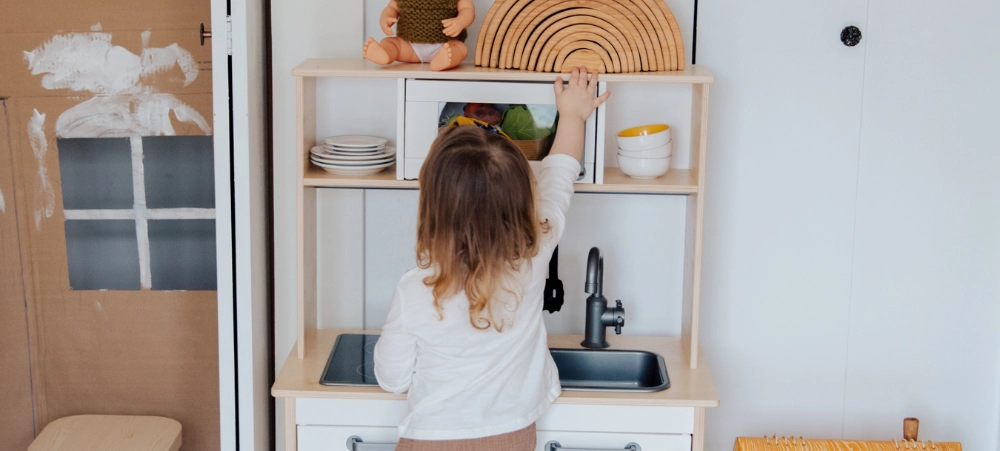The Montessori approach to education, developed by Dr. Maria Montessori, is all about fostering independence, creativity, and a love for learning in children. While Montessori classrooms are widely known for their hands-on learning environments, you can also create a Montessori-inspired atmosphere in your own home with just a few simple tweaks. Here’s how to embrace Montessori at home and enjoy the many benefits it can offer for your child’s development.
What is Montessori?
Montessori is an educational philosophy based on the belief that children learn best when they are given the freedom to explore and engage with their environment at their own pace. The Montessori method emphasises self-directed activity, hands-on learning, and collaborative play. Children are encouraged to make choices, explore their interests, and develop a sense of responsibility for themselves and their surroundings.
While traditional schooling methods focus on structured lessons and teacher-led activities, Montessori offers a more organic approach that allows children to take the lead in their learning.
How to Implement Montessori at Home
You don’t need a formal Montessori classroom to bring these principles into your home. With a few simple changes, you can create a nurturing environment that supports your child’s development and independence. Here are some easy tweaks to get started:
1. Create a Child-Friendly Space
One of the key elements of Montessori is creating an environment that’s tailored to the child’s size and abilities. Make sure your home is child-friendly by:
- Lowering shelves, hooks, and mirrors to child-level so your child can easily access toys, books, and personal items.
- Offering simple, age-appropriate furniture like small tables and chairs, allowing your child to comfortably participate in activities.
- Creating a calm, clutter-free space to encourage focus and reduce distractions.
Benefit: A child-friendly environment fosters independence and allows your child to take ownership of their space.
2. Incorporate Practical Life Activities
In the Montessori method, everyday tasks are viewed as learning opportunities. Practical life activities help children develop fine motor skills, independence, and responsibility. Try incorporating these activities at home:
- Dressing: Let your child practice putting on and taking off their clothes. Provide clothing with simple buttons, zippers, or Velcro for practice.
- Cleaning: Set up a child-sized broom, dustpan, or mop so your child can help with household chores.
- Cooking: Allow your child to participate in meal preparation. Simple tasks like stirring, washing vegetables, or setting the table can be both fun and educational.
Benefit: These activities help children gain a sense of accomplishment and confidence while also promoting essential life skills.
3. Use Natural, Open-Ended Toys
Montessori encourages the use of open-ended toys that allow children to use their creativity and imagination. Unlike traditional toys that may be limited to a specific function, open-ended toys can be used in a variety of ways, stimulating problem-solving and creative thinking.
- Wooden blocks: These can be used for building, sorting, and creating, providing endless opportunities for imaginative play.
- Dolls and figurines: Encourage pretend play and storytelling.
- Art supplies: Offer materials like crayons, markers, clay, and paints to allow your child to express themselves freely.
Benefit: Open-ended toys help children develop their imagination, creativity, and problem-solving skills.
4. Encourage Independent Decision-Making
In Montessori, children are encouraged to make their own choices in a way that respects their autonomy. By giving children the freedom to make decisions, they develop a sense of responsibility and confidence. Here’s how you can support your child’s decision-making skills:
- Offer choices: Instead of asking your child what they want to do, give them options. For example, ask, “Would you like to play with blocks or read a book?”
- Encourage self-care: Let your child decide when they’re ready for a nap, when they want to eat, or when they need to use the bathroom.
- Respect their preferences: Support their interests by allowing them to choose which activities they want to pursue and for how long.
Benefit: Encouraging independent decision-making helps children develop confidence and a sense of responsibility for their actions.
5. Foster a Love for Learning
In a Montessori home, learning is seen as a lifelong journey, not just something that happens in a classroom. To foster a love for learning, try these strategies:
- Create a rich environment: Fill your home with books, art, music, and natural elements that invite curiosity and exploration.
- Follow your child’s interests: Pay attention to what excites your child and provide resources that support their interests. If your child loves nature, explore outdoor activities together or create a nature-based learning project.
- Encourage exploration: Provide opportunities for your child to explore the world around them. Take trips to the park, museum, or library, and ask open-ended questions to promote discussion.
Benefit: Encouraging a love for learning helps children become self-motivated and enthusiastic about discovering new things.
6. Introduce a Routine
While Montessori encourages flexibility, children still thrive in a structured environment. Having a consistent routine helps children feel secure and understand what to expect throughout the day.
- Morning routine: Include activities such as getting dressed, brushing teeth, and eating breakfast in a predictable order.
- Daily tasks: Set aside specific times for meals, naps, playtime, and quiet time to help your child understand how to organise their day.
- Nighttime routine: Establish a calming bedtime routine with activities such as reading, brushing teeth, and singing lullabies.
Benefit: A routine gives children a sense of security and helps them develop time-management skills.
7. Encourage Reflection
At the end of each day, take a few moments to reflect on your child’s experiences. Montessori emphasises the importance of reflection and self-awareness, so try to make it a part of your child’s daily routine.
- Ask your child about their favourite part of the day.
- Discuss what they learned or what made them happy.
- Offer gentle feedback to encourage self-awareness and emotional growth.
Benefit: Reflection helps children develop emotional intelligence and an understanding of their own experiences.
Final Thoughts
Montessori at home doesn’t have to be complicated or expensive. With a few simple changes, you can create an environment that encourages your child’s independence, creativity, and love for learning. By making your home child-friendly, incorporating practical life activities, using open-ended toys, and encouraging independent decision-making, you’ll be supporting your child’s development and helping them thrive. The key is to be patient, flexible, and responsive to your child’s needs, all while creating an environment that allows them to explore and grow at their own pace.
Sources:
We understand that there are many aspects that encompass a Mother, Father or Child and strive toward providing resources and services that accommodates this.
Our content is aimed to inform and educate families on issues starting from pregnancy through to the challenges of the teen-age years.
- From Pain to Possibility: Panado®’s New Marketing Campaign, Highlights The Joy Of Pain Relief - December 10, 2025
- Feeding Unicorns by Jeni-Anne Campbell: A bold new book for business leaders who care - December 9, 2025
- The Benefits of PLAYMOBIL – Through the Eyes of a Qualified Play Therapist - December 2, 2025





